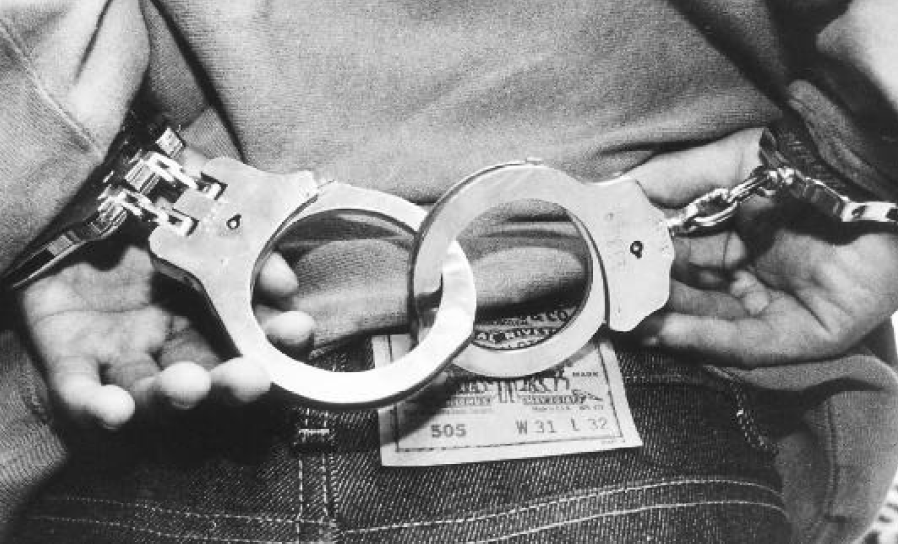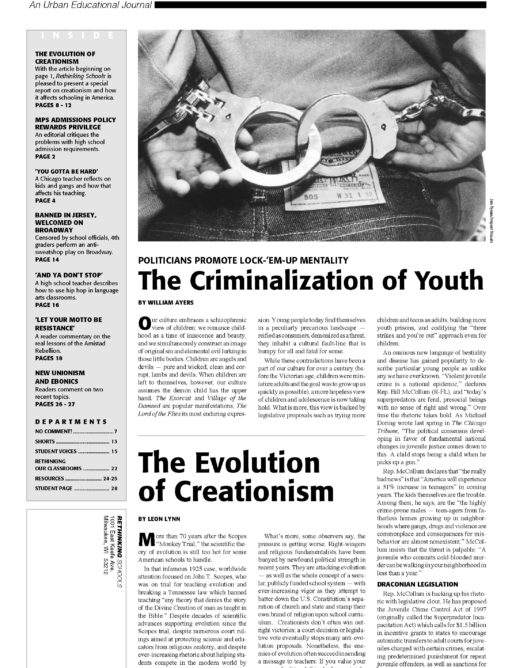The Criminalization of Youth
Politicans Promote Lock-"Em-Up Mentality

Our culture embraces a schizophrenic view of children: We romance childhood as a time of innocence and beauty, and we simultaneously construct an image of original sin and elemental evil lurking in those little bodies. Children are angels and devils — pure and wicked, clean and corrupt, lambs and devils. When children are left to themselves, however, our culture assumes the demon child has the upper hand. “The Exorcist” and “Village of the Damned” are popular manifestations, “The Lord of the Flies” its most enduring expression. Young people today find themselves in a peculiarly precarious landscape — reified as consumers, demonized as a threat, they inhabit a cultural fault-line that is bumpy for all and fatal for some.
While these contradictions have been a part of our culture for over a century (before the Victorian age, children were miniature adults and the goal was to grow up as quickly as possible), a more hopeless view of children and adolescence is now taking hold. What is more, this view is backed by legislative proposals such as trying more children and teens as adults, building more youth prisons, and codifying the “three strikes and you’re out” approach even for children.
An ominous new language of bestiality and disease has gained popularity to describe particular young people as unlike any we have ever known. “Violent juvenile crime is a national epidemic,” declares Rep. Bill McCollum (R-FL), and “today’s superpredators are feral, presocial beings with no sense of right and wrong.” Over time the rhetoric takes hold. As Michael Doring wrote last spring in The Chicago Tribune, “The political consensus developing in favor of fundamental national changes in juvenile justice comes down to this: A child stops being a child when he picks up a gun.”
Rep. McCollum declares that “the really bad news” is that “America will experience a 31% increase in teenagers” in coming years. The kids themselves are the trouble. Among them, he says, are the “the highly crime-prone males — teen-agers from fatherless homes growing up in neighborhoods where gangs, drugs and violence are commonplace and consequences for misbehavior are almost nonexistent.” McCollum insists that the threat is palpable: “A juvenile who commits cold-blooded murder can be walking in your neighborhood in less than a year.”
Draconian Legislation
Rep. McCollum is backing up his rhetoric with legislative clout. He has proposed the Juvenile Crime Control Act of 1997 (originally called the Superpredator Incapacitation Act) which calls for $1.5 billion in incentive grants to states to encourage automatic transfers to adult courts for juveniles charged with certain crimes, escalating predetermined punishment for repeat juvenile offenders — as well as sanctions for their parents — and the public release of previously sealed juvenile criminal records. With its aggregation of certain youth into a convenient and manageable mob and its one-size-fits-all simplicity, it passed the House 286-132 and moves, with the Clinton administration’s support for key provisions, inexorably toward the Senate. Rep. McCollum’s bill represents a decisive withdrawal from a century of difficult, uneven progress in relation to juvenile justice, undermining the fundamental thesis that a child in crisis, a child in trouble, is still a child.
Rep. McCollum relies on an entirely inaccurate popular impression that youth crime is a runaway train, reckless, out of control, unpredictably dangerous, picking up speed as it careens down the track toward our town or neighborhood. We read about teenagers being “wild in the streets” and of a “ticking demographic time bomb,” the 3-year-olds of today morphing overnight into tiny monsters in sneakers.
The truth is more complicated. The overwhelming majority of kids are not criminals — less than one-half of one percent of youth 10-17 are charged with violent crimes. In fact, youth crime is relatively flat over decades and juvenile arrests for violent offenses have declined dramatically for the last three years. Youth murder is up, it’s true, but why? Access to guns. What would have been a terrible incident twenty years ago — a brutal fight, a kid hit by another kid with a baseball bat — is now too often fatal. Today the immature, impulsive kid can get a gun.
While each instance of youth-on-youth violence is alarming, the hidden, terrible truth is that most murder victims under 18 are killed by adults; 70% of the murderers of children in 1994 were adults, and it is six times more likely that a parent will kill his or her teenage child than the other way around.
Under Rep. McCollum’s bill, we would return to the practices of the 19th century, erasing the distinctions between children and adults, thrusting youngsters into adult courts and prisons, ensuring that they are preyed upon sexually and physically, hardened and destroyed. Six in 10 juveniles tried as adults are non-violent offenders, and headline-grabbing youth crimes account for less than 1% of all juvenile delinquency. But once in adult prisons, youth are twice as likely to be beaten or to commit suicide and five times as likely to be sexually assaulted. Those who survive have higher recidivism rates than kids charged with similar offenses but kept under the supervision of juvenile courts.
Ironically, McCollum-type proposals — tough-sounding but ineffective — contribute to rising crimes rates.Transferring children as young as 13 years old automatically to adult courts without a juvenile hearing is already creating a peculiarly American gulag for the poor in states that have vigorously pursued this approach. In Rep. McCollum’s own Florida, one of the severest get-tough states, youth sentenced to adult courts return to criminal activity and commit consistently more serious crimes than their counterparts who remain under the jurisdiction of juvenile courts. Florida’s approach — which denies judges the opportunity to examine the specific circumstances of each case, uncovering the particular problems and possibilities in each situation, and then opens confidential records just as disaffected young people are struggling to reintegrate into society — is an economic death sentence for many. It guarantees a growing population that is hurt, hopeless, and angry.
Zero Tolerance
We seem almost always to respond to teenagers with an authoritarianism in the name of clarity and standards. For example, “zero tolerance” seems to be becoming a favorite phrase, promoted as clarifying what might have been perceived as murky, ambiguous. It’s odd though: I don’t have any murkiness at all on drug abuse, for example. I think cigarettes are toxic, alcohol poisonous — heavier drugs are even worse — and so I don’t use them, and I strongly disapprove of their use. What does saying I have “zero tolerance” for them add? It sounds tougher, perhaps, but what would I do, for example, what action would I take if I saw someone abusing alcohol? Kill them? Jail them? Punch them out? Expel them? Sounding tough is quite a different thing from prescribing what that toughness entails. And since contexts and circumstances are always specific and often complex, wise prescriptions will likely be various.Furthermore, saying I have “zero tolerance” for alcohol gives it an oddly privileged position. How much tolerance do I have for sexual abuse? For bigotry? Intolerance or disrespect? Meanness or thoughtlessness? Well, it’s clear that these are complicated. “Zero tolerance” simplifies, closes the door to conversation. Move into more complicated issues and the need for conversation only intensifies. Young people, in particular, need steady grown-ups to talk to, to think with, to bounce back off of. Closing the door is a form of abandonment, of neglect.
Refine Our Standard
We should refine our standard and ask, what if this were my child? The question cannot be about some abstract child, every child, the mob of children. That turns other people’s children into things, objectifies them. To ask, is it good enough for my child? — not, is it a perfect arrangement for my child? — is to begin to set limits of acceptability. Personalizing our approach to juveniles does not mean that there are no serious consequences to action or behavior, but it does remind us that a child who breaks the law will return to society someday, and that among our central goals must be recovery. It reminds us that our efforts on behalf of our children and other people’s children must include cleaning up their environment — removing adult-controlled toxic elements like guns and drugs — and a sustained struggle to provide productive work, decent schools, and community centers to support and challenge them, to engage their hopes and dreams and capacities. We must fight for the obvious: a child in crisis, a child in trouble, is still a child.

